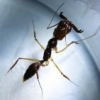The yellow mold has taken over a large part of the nest now. I've had them connected to a new nest for a few days now. I let the old nest dry out, and hydrated the new nest and added heat. Some workers found it right away, but only a few moved. Today I see they transferred the mold to the new nest, now I have two moldy nests and no idea where to go from here. They are dying off, and piling the dead on the mold. They are so slow, being so close to hibernation. I think this is the end for them. I will need to make a new nest, I have all mine used up at the moment.
I'm also scared my other colonies are at risk. Any suggestions? I'm going to try putting a heat lamp on the nest area to see if excessive heat will move them. But if I move them to the new nest will they transfer the spores?
Edited by AntsMAN, October 5 2016 - 4:40 PM.






















